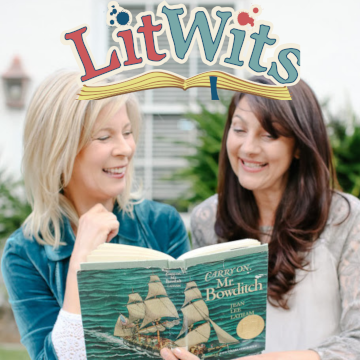LitWits helps bring favorite books to life in hands-on, creative ways. They provide free Creative Teaching Ideas for more than 40 books with instructions for fun, immersive activities, all connected to the story itself. They were created for use with groups of students ages seven through twelve. These straight-from-the-story experiences give children opportunities to do what the characters did and learn what the characters learned.
There are numerous study guides for novels that are available to homeschoolers, but most concentrate on academic skills. LitWits puts far less stress on academics with, for example, less work on vocabulary than you find in most novel study guides. Instead, they focus on engaging students in the stories so they develop a love for literature.
A LitWits "field trip through a great book" is available in four ways:
1) Live online classes are offered each semester. Enrollment is by the semester and gives students access to six workshops on six novels. Students are mailed supplies and printables in advance.
2.) You can purchase access to their video workshops, which come with all the necessary printables and a list of supplies to gather.
3.) You can use their free Creative Teaching Ideas to do a study on your own (as I describe below). Each "Ideas" page contains everything done in a live workshop for that novel You also have the option to buy a set of printable templates, activity pages, academic worksheets, and answer keys.
Prep Work
Whether your child is participating in a workshop or you’re using LitWits’ Creative Teaching Ideas to do your own study of a novel, you’ll have some supplies to gather. Besides the book itself, and supplies for selected activities, you might want to gather three to five props. Props might relate to the setting or theme of the story. Each book's Ideas page has a collection of prop images that should give you some inspiration. If you don't have time, you might use images, or just don't worry about props at all.
The Lessons
Each novel's Ideas page hones in on a few key values and themes from the selected book, which Lit Wits calls “Takeaways.” For example, for the book Carry On, Mr. Bowditch, the takeaways are perseverance, attitude, and directions. Each of these is explored from a number of angles. As the authors explain regarding the takeaway “directions:” “There are multiple ‘directional’ messages in Nat’s story: the importance of establishing clear directions, going in the right direction, of following directions, and of finding one’s own direction.” You can use projects and prompts from their ideas, as well as props that you gather to stimulate discussion on these topics. Some of these discussions could be directed into spiritual applications, especially those addressing virtues and decision-making, but it’s up to parents to lead discussions as they choose. The secular nature of these studies is especially evident in studies such as that for Pinocchio. The original book, Pinocchio, is loaded with religious allegory, but this isn’t brought out in the takeaways.
Activities
Hands-on and multi-sensory activities make these studies even more fun. For example, In Carry On, Mr. Bowditch students learn about a compass rose and then paint one with watercolors. They listen to maritime music from the era. They create their own compass with sewing needles, magnetite (or a magnet), and a cork. Using a template, they create a logbook in which they can track their own journeys. Students can also role-play using prompts that make it easy to present short skits in an impromptu fashion. Of course, you want to add the types of food mentioned in the story. In this case, it might be hardtack, beef jerky, or citrus fruits.
Among the academic activities in Carry On, Mr. Bowditch are:
- Analyze John 1:1 as Nathaniel Bowditch analyzed Scripture to teach himself Latin, French, and Spanish. (This is meant to be a linguistics exercise rather than a Bible study.)
- Rewrite a paragraph to make it accurate and easy to understand.
- Complete a narrative arc worksheet.
- Complete a vocabulary worksheet, identifying English words that derive from Latin.
- Complete a worksheet identifying the setting (on a map) and time period (on a timeline) of the story.
(Remember that you have the option to buy printable templates, activity pages, academic worksheets, and answer keys.)
"Learning Links" within each book's page take you to useful websites for more information and activity ideas. In the study for Carry On, Mr. Bowditch, you might check out images of Nathaniel Bowditch, an article about real ships of Bowditch’s era, a diagram of a warship from 1728, a “kid-friendly” explanation of yellow fever, the latest edition of Bowditch’s famous book, American Practical Navigator, and other web links that enrich the study.
A “Beyond the Book” section adds additional activity suggestions. For Carry On, Mr. Bowditch, these include ideas such as visiting Bowditch’s home in Salem, Massachusetts (if that’s possible); making your own spyglass; or making your own sextant.
Working with Different Ages
Students in the primary grades can participate by listening to an audiobook presentation of a novel if they are not yet able to read the novel itself. Older students can read independently, or you can use books as family read-alouds. While the reading and academic activities might be done independently, many of the other activities are best suited to a group of two or more students. Younger students might skip some of the academic work. (It seems to me that the ideal grade levels for these studies are grades four through eight.)
Summary
LitWits' experiential, hands-on approach might well be more successful in getting students excited about reading good literature than a more academic approach.








